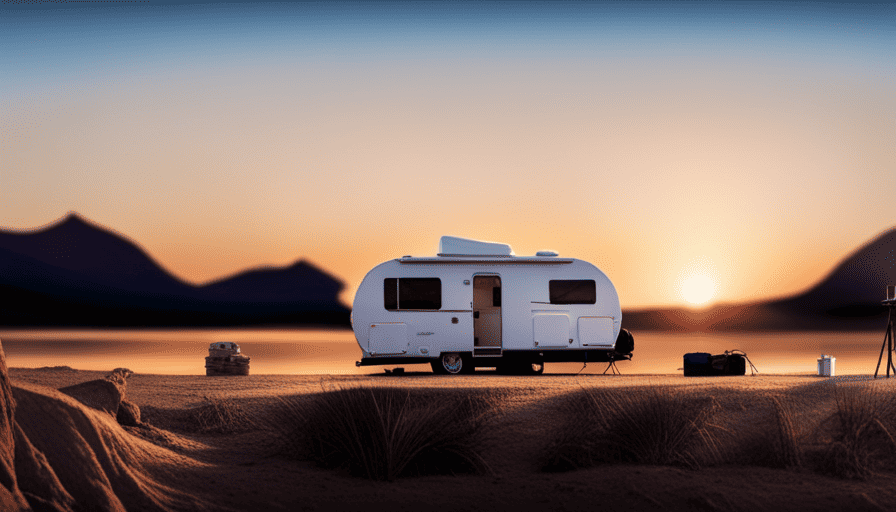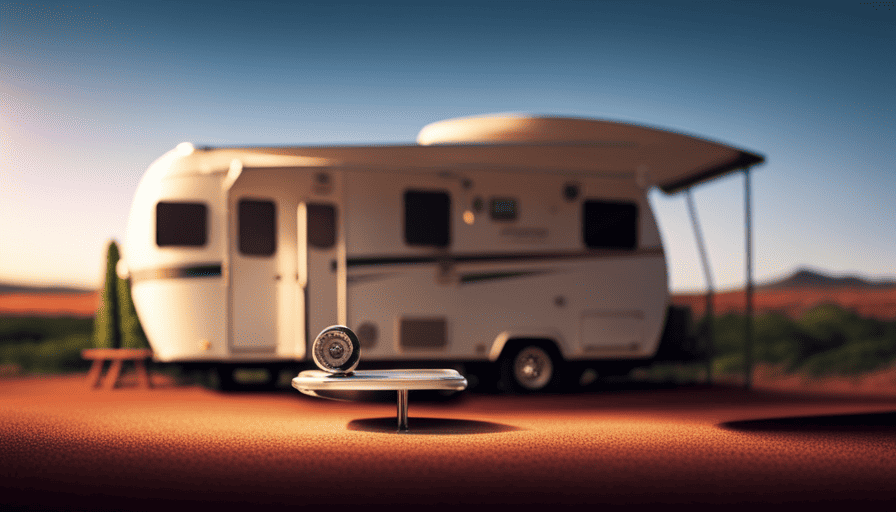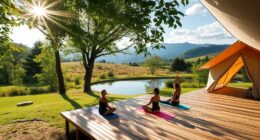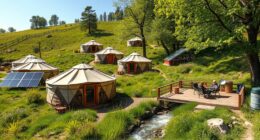Fed up with your toes turning into icicles on your camping trips? Worry no more, as I bring you some electrifying advice to stay cozy in your pop-up camper without the need for electrical power! Believe me, these tricks are so powerful, you’ll think you’re soaking up the heat in a lush tropical getaway.
From insulating your camper to investing in alternative heating methods, I’ll show you how to turn your chilly camper into a cozy haven. With a portable propane heater or even a wood-burning stove, you’ll be toasty warm no matter how frigid the weather gets. And don’t forget about thermal blankets, layers, and thermal clothing – they’re your secret weapons against the cold.
So, whether you’re a seasoned camper or just starting out, get ready to heat up your pop up camper like a pro. Say goodbye to shivering nights and hello to a camping experience that’s as warm and inviting as a crackling fireplace.
Let’s dive right into the electrifying world of heating your pop up camper without electricity!
Key Takeaways
- Insulate the camper to retain heat and keep cold air out
- Use energy efficient heating options like portable propane heaters, electric heaters, or solar-powered options
- Consider investing in a wood-burning stove and install a chimney, following safety precautions
- Use thermal blankets or sleeping bags, layering them or combining them with sleeping bags for enhanced insulation
Insulate Your Camper
If you want to stay cozy in your pop-up camper even without electricity, it’s crucial to insulate it properly. Camper insulation is the key to retaining heat and keeping the cold air out.
One way to insulate your camper is by using thermal curtains or window coverings. These can help to reduce heat loss through the windows and keep the warmth inside.
Another option is to add insulation to the walls and ceiling of your camper. There are various materials available, such as foam board insulation or reflective insulation, that can be easily installed to increase the energy efficiency of your camper.
In addition to proper insulation, you may also want to consider energy efficient heating options. One popular choice is a portable propane heater. These heaters are easy to use and provide a reliable source of heat. They typically come with a built-in safety feature that shuts off the heater if it detects low oxygen levels or if it gets tipped over. Portable propane heaters are also compact and lightweight, making them perfect for use in a pop-up camper.
By insulating your camper and using a portable propane heater, you can ensure a warm and comfortable camping experience, even without electricity.
Now let’s move on to the next section about how to use a portable propane heater.
Use a Portable Propane Heater
To keep your cozy home on wheels toasty, simply grab a portable propane heater and bask in the warm glow it emits. Portable propane heaters are a great option for heating your pop-up camper when you don’t have access to electricity. Here’s why they’re a practical choice:
-
Convenience: Portable propane heaters are easy to use and require minimal setup. Just connect the propane tank, ignite the heater, and enjoy the heat.
-
Portability: These heaters are designed to be lightweight and compact, making them easy to carry and store in your camper.
-
Safety: Most portable propane heaters come with safety features such as automatic shut-off valves and built-in carbon monoxide detectors, ensuring your safety while using them.
If you’re looking for alternative heating options, there are also portable electric heaters and solar-powered heating options available. Portable electric heaters can be plugged into a generator or power source, providing heat without the need for propane. Solar-powered heating options utilize the sun’s energy to generate heat and can be a sustainable choice for off-grid camping.
Now that you know how to heat your pop-up camper with a portable propane heater, let’s explore another heating option: investing in a wood-burning stove.
Invest in a Wood-Burning Stove
Immerse yourself in the cozy atmosphere of your mobile home by investing in a wood-burning stove, a rustic and charming heating option that adds a touch of warmth and nostalgia to your travels.
When it comes to heating your pop-up camper without electricity, a wood-burning stove is a reliable and efficient choice.
To begin, you’ll need to install a chimney for your wood-burning stove. This involves drilling a hole through the roof of your camper and carefully fitting the chimney pipe. It’s important to follow the manufacturer’s instructions and ensure that the chimney is properly sealed to prevent any leaks or potential fire hazards.
While using a wood-burning stove, it’s crucial to take safety precautions. Make sure to place the stove on a fire-resistant surface and keep flammable materials away from it. Always monitor the stove while it’s in use and have a fire extinguisher nearby, just in case.
Now, let’s transition to the next section about using thermal blankets or sleeping bags to further enhance your warmth and comfort during cold nights.
Use Thermal Blankets or Sleeping Bags
Get cozy and stay warm during chilly nights in your mobile home by using thermal blankets or sleeping bags, which will provide extra insulation and ensure a comfortable and restful sleep. When it comes to heating a pop-up camper without electricity, these alternative solutions are essential. Thermal blankets and sleeping bags are designed to trap and retain body heat, keeping you warm even in the coldest temperatures.
To give you an idea of the effectiveness of thermal blankets and sleeping bags, take a look at the comparison table below:
| Thermal Blankets | Sleeping Bags |
|---|---|
| Lightweight and compact | Insulated and thick |
| Reflective material retains heat | Synthetic or down insulation |
| Can be used as a layering option | Zipper closure for easy access |
| Durable and easy to clean | Hooded for added warmth |
These options allow you to choose the best fit for your needs, ensuring maximum comfort and warmth while camping. Additionally, layering thermal blankets or using them in combination with sleeping bags can enhance their insulation capabilities.
Next, let’s explore another practical method to stay warm in your pop-up camper: wearing layers and using thermal clothing. This will provide an additional barrier against the cold and help you retain body heat.
Wear Layers and Use Thermal Clothing
Bundling up in layers and donning cozy thermal clothing is like wrapping yourself in a toasty hug, ensuring you stay warm and snug inside your mobile home. Layering your clothing provides numerous benefits when it comes to staying warm without electricity. By wearing multiple layers, you trap warm air between each garment, creating an insulating barrier that helps retain body heat.
Start with a moisture-wicking base layer to keep sweat away from your skin. Then, add a mid-layer made of fleece or wool for extra insulation. Finally, top it off with a waterproof and windproof outer layer to shield yourself from the elements.
When it comes to thermal clothing options, there are plenty to choose from. Look for thermal underwear, socks, hats, gloves, and even thermal sleeping bag liners. These specialized garments are designed to provide maximum warmth and comfort in cold temperatures. They’re often made from materials like merino wool or synthetic fibers that have excellent insulation properties. Additionally, consider investing in heated clothing, such as heated jackets or gloves, which have built-in electric heating elements that can be powered by portable battery packs.
Now, let’s transition into the next section about using hot water bottles or heat packs to further enhance your warmth and comfort inside your pop-up camper.
Use Hot Water Bottles or Heat Packs
Cozy up with hot water bottles or heat packs to add an extra layer of warmth and comfort to your mobile home experience. When you’re camping in a pop-up camper without electricity, staying warm becomes a top priority. Here are some hot water bottle alternatives and the benefits of using heat packs:
-
Heat packs: These small, portable packs are filled with a gel or liquid that can be heated up and then used to warm your body. They’re easy to use and provide a long-lasting heat source.
-
Instant hand warmers: These disposable heat packs are perfect for keeping your hands warm during chilly nights. Simply activate them by shaking or breaking a small metal disc inside, and they’ll provide hours of warmth.
-
Electric heated blankets: While you may not have access to electricity, there are battery-powered heated blankets available that can provide warmth without needing an outlet.
-
Microwavable heating pads: These pads can be heated in a microwave and then used to warm your bed or provide targeted heat to specific areas of your body.
Using hot water bottles or heat packs is a great way to stay warm and comfortable in your pop-up camper. The benefits include portability, long-lasting heat, and the ability to target specific areas of your body. Now, let’s move on to the next section about cooking inside the camper to generate heat.
Cook Inside the Camper to Generate Heat
After exploring the option of using hot water bottles or heat packs to warm up your pop-up camper, let’s move on to another practical method: cooking inside the camper to generate heat. Not only will this help warm up the space, but it also serves the dual purpose of providing nourishment.
When cooking inside your camper, it’s crucial to prioritize safety. Ensure proper ventilation by cracking open a window or using the stove’s exhaust fan to prevent carbon monoxide buildup. Also, make sure to keep a fire extinguisher handy and never leave the stove unattended while it’s in use.
To generate heat, consider cooking with alternative fuel sources that can be used indoors, such as a propane stove or a portable camping stove. These options are safe and efficient, providing both warmth and a means to prepare meals. Additionally, using a cast iron skillet or pot can help retain heat and distribute it evenly throughout the camper.
Now that you know how to cook inside your pop-up camper for heat and sustenance, let’s move on to the next method: parking in sheltered areas or using windbreaks. This will further enhance your camping experience by minimizing the impact of cold winds and maximizing heat retention.
Park in Sheltered Areas or Use Windbreaks
One way to maximize warmth while camping is to park your camper in sheltered areas or use windbreaks, which can reduce heat loss by up to 50%. When choosing a parking spot for your pop-up camper, look for areas that are protected from strong winds and offer natural barriers, such as trees or hills, that can act as windbreaks. These barriers will help to block the cold air from reaching your camper and prevent heat loss.
If you don’t have access to natural windbreaks, you can also create your own using various materials. Some popular windbreak options include portable panels, tarps, or even large pieces of cardboard. These materials can be set up around your camper to provide an additional layer of protection against the wind. Just make sure to securely anchor them to prevent them from blowing away.
By parking in sheltered areas or using windbreaks, you can significantly reduce the amount of heat lost from your pop-up camper. This will help to keep the interior warmer and more comfortable, even without electricity.
In the next section, we will explore another method to heat your camper by using reflective window covers or insulated curtains.
Use Reflective Window Covers or Insulated Curtains
To make your camping experience more enjoyable and relatable, consider using reflective window covers or insulated curtains to keep the interior of your camper warm and comfortable. These simple additions can greatly improve the insulation of your camper and help retain heat during cold nights.
Here are three reasons why reflective window covers and insulated curtains are a great option:
-
Reflective window covers: These covers are designed to reflect heat back into the camper, preventing it from escaping through the windows. They also provide privacy during the day while still allowing natural light to enter. However, it’s important to note that reflective window covers can limit your view outside, so consider this trade-off before using them.
-
Insulated curtains: Installing insulated curtains can help prevent heat loss through the windows and provide an extra layer of insulation. Look for curtains made with thick, thermal materials such as fleece or quilted fabric. Be sure to measure your windows accurately to ensure a proper fit.
-
Alternative options: If reflective window covers or insulated curtains don’t meet your needs, consider alternative heating methods such as a catalytic heater or portable fireplace. These options can provide additional warmth without the need for electricity.
By using reflective window covers or insulated curtains, you can effectively keep your pop-up camper warm and cozy during your camping adventures. However, if these options don’t suit your preferences, consider alternative heating methods for a comfortable camping experience.
Consider Alternative Heating Methods, such as a Catalytic Heater or Portable Fireplace
Consider using a catalytic heater or portable fireplace as an alternative method to keep your camper warm and cozy during your camping adventures, even if you’re concerned about the potential for carbon monoxide emissions. These heating options provide efficient and effective ways to heat your pop-up camper without relying on electricity.
A catalytic heater is a great choice for heating a pop-up camper as it operates on propane and doesn’t require any electricity. It uses a catalytic reaction to produce heat, making it safe and efficient. These heaters are portable and can be easily moved around your camper to provide heat wherever you need it. They also have built-in safety features, such as automatic shut-off mechanisms, to ensure peace of mind.
Another option is a portable fireplace, which can add a cozy ambiance to your camper while also providing heat. These fireplaces are typically fueled by propane or wood pellets and can be easily transported and set up in your pop-up camper. They offer the added benefit of a visible flame, creating a warm and inviting atmosphere.
When using either a catalytic heater or a portable fireplace, it’s important to follow the manufacturer’s instructions and safety guidelines. Proper ventilation is crucial to prevent the build-up of carbon monoxide, so make sure your camper has adequate airflow. Additionally, always have a carbon monoxide detector installed in your camper for added safety.
By considering alternative heating methods like a catalytic heater or portable fireplace, you can enjoy a warm and cozy camping experience in your pop-up camper, even without electricity.
Frequently Asked Questions
Can I use a portable propane heater inside my pop up camper?
Yes, you can use a portable propane heater inside your pop-up camper as an alternative heating method. It’s important to ensure proper ventilation and follow the manufacturer’s instructions to prevent any safety hazards. However, if you’re looking for an alternative to propane heaters, you can also consider using a portable electric heater. These heaters are convenient and can provide sufficient warmth, making them a great option for heating your pop-up camper without electricity.
How can I prevent condensation from building up inside my insulated camper?
To prevent condensation from building up inside my insulated camper, I follow a few key tips.
Firstly, I make sure to properly ventilate the space by cracking open windows or using vent fans. This helps to circulate the air and reduce moisture buildup.
Additionally, I use moisture-absorbing products like silica gel packs or dehumidifiers.
Finally, I insulate any cold surfaces such as windows or metal frames to prevent them from becoming dew points.
These insulation tips for pop up campers have proven effective in minimizing condensation.
Are there any safety precautions I should take when using a wood-burning stove in my pop up camper?
Safety precautions should always be taken when using a wood-burning stove in a pop-up camper. First, ensure that the stove is properly installed and meets all safety regulations.
It’s important to have proper ventilation to prevent carbon monoxide buildup, so make sure to open a window or use a vent while the stove is in use. Additionally, always keep a fire extinguisher nearby and never leave the stove unattended.
How effective are thermal blankets or sleeping bags at keeping the camper warm?
Thermal blankets and sleeping bags can be effective in keeping a pop-up camper warm, but their effectiveness may vary depending on the temperature and insulation of the camper. Electric heaters are generally more effective at providing consistent and reliable heat. However, if you’re looking for alternative heating methods for a pop-up camper without electricity, options like propane heaters or wood-burning stoves can be considered. It’s important to carefully follow safety precautions and ensure proper ventilation when using these alternative heating methods.
Can I use a catalytic heater or portable fireplace as the primary heating source for my pop up camper?
Yes, you can use a catalytic heater or portable fireplace as the primary heating source for your pop-up camper. However, it’s important to prioritize safety when using a catalytic heater. Make sure to choose a model specifically designed for indoor use and follow all safety guidelines provided by the manufacturer.
Additionally, there are alternative options to a portable fireplace, such as propane heaters or wood-burning stoves, that can also provide effective heating for your camper.
Conclusion
In conclusion, heating a pop-up camper without electricity is definitely possible with the right preparations and equipment. By insulating your camper, using portable propane heaters or wood-burning stoves, and utilizing thermal blankets or sleeping bags, you can stay warm and cozy even in chilly weather.
Don’t forget to dress in layers and invest in thermal clothing for added warmth. Additionally, cooking inside the camper and parking in sheltered areas can help generate heat.
Remember, with a little creativity and resourcefulness, you can turn your pop-up camper into a warm and inviting home away from home, even in the coldest of conditions.










